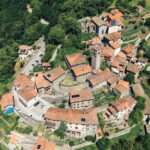The survival of mountain populations was, in the past centuries, linked to the production of flour, whether from chestnuts or cereals. Fosciandora was no exception: actually it is an area largely covered by chestnut woods and it allowed a significant production of chestnut flour. The hills were not suited to cereal cultivation, but wheat, corn, rye, spelt and oats were grown in the few flat areas and on the terraces. Archive documents and bibliographical references (Gian Mirola and Ivano Stefani) show that in 1868 there were 15 water mills in the area, reduced to 11 in 1875. To get an idea of the amount of crops, the data from the milling tax of 1869 show that in that year were milled 360 quintals of wheat, 430 quintals of corn and rye and 1260 quintals of other cereals, including dried pulses and chestnuts. The largest production was ensured by the Municipal Mill located in Salotti on the Ceserano river. Apart from small structures on the Ribonosori and Rio streams, most of the mills were located along the Ceserano and Rimonio rivers. Some of them were equipped with more than a single millstone, used according to the product to be ground. In this sense the most important was the Mulino di Sotto (also called Molin Vecchio), located under Lupinaia along the Rimonio, with four different millstones working. There were, however, several mills along the Rimonio river and its tributaries; one of these was the Cerreta Mill, of which only the ruins and some traces of the water inflow and outflow channellings remain.







